Injection molding is the most commonly used process to manufacture plastics parts. However, this dynamic and complex manufacturing process requires the control of numerous variables in order to produce quality parts. Both designers and engineers commonly use injection molding simulation to validate their plastic part design prior to shooting any plastic. In some cases injection molding simulation is extended to help determine the size of the processing window. However, the use of simulation has often been limited to the conventional “guess-and-check” approach. While this approach can be effective, it is often limited to the previous experience of the engineer or analyst. Additionally, this approach limits the ability of the engineer or analyst to identify the sensitivity of an input variable on the overall process.
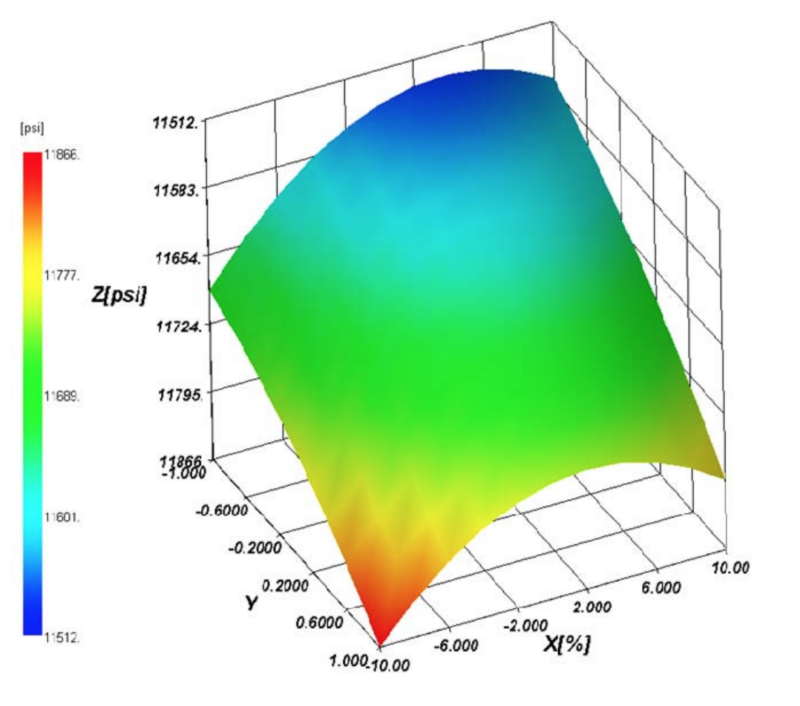
Figure 1: Performing a virtual DOE can provide a response surface plot that helps illustrate the effect different input variables have on a desired result.
Utilizing design of experiments (DOE’s) with simulation, can help expand the findings available and allow the end customer to better understand their process and product. The goal of both injection molding simulation and design of experiments is to obtain information quickly and efficiently. However, the two methods are often decoupled from one another with simulation implemented during the design phase, and DOE reserved for hands-on testing after the mold is constructed. By coupling the two techniques, often referred to as a virtual DOE, significant insight can be gained regarding the sensitivity of part design and process parameters on the desired result. This allows for more informed decisions to be made regarding minimum part wall thickness, critical rib thickness and dimensional stability of the part.
Virtual DOE creates an ordered structure for the design evaluation in simulation. Instead of running fifteen different simulations independently, an analyst can use a DOE to select multiple different variables and systematically change the variables to determine the relationship to a desired response. By running the DOE, the analyst can look at a response surface, Figure 1, rather than a series of independent results. The non-planar response surface conveys information regarding how a desired response changes with alterations to the input variables. A virtual DOE can also be an efficient use of time. While parameters such as mold and melt temperature can take a significant amount of time to change in a physical DOE, in a virtual DOE, it is simply a value change of a parameter. Virtual DOE also allows for variables that cannot be easily changed in a physical DOE, like wall thickness and gate size, to be easily incorporated into the study. Finally, the virtual DOE can supplement the set-up of a physical DOE by helping select the critical variables to test at the press.
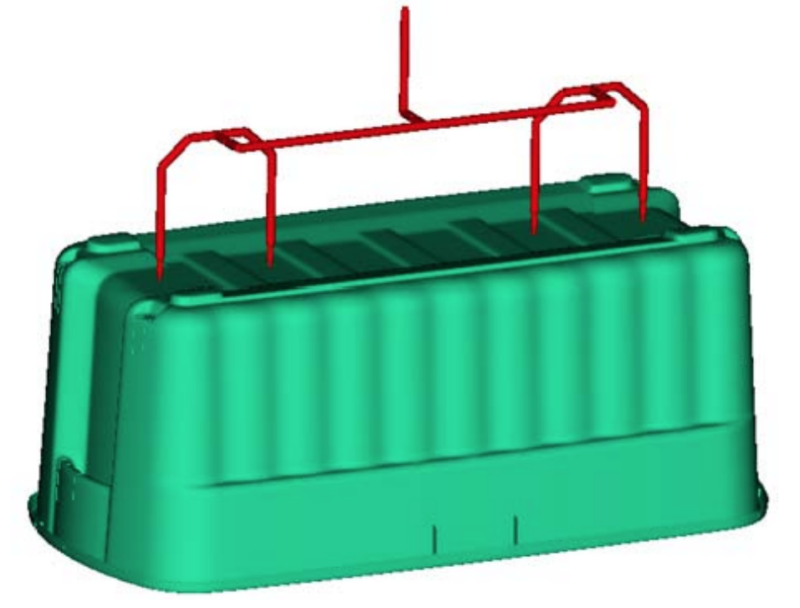
Figure 2: Container geometry used for virtual DOE.
Virtual DOE is not limited to only mold filling issues. The DOE technique can extend into cooling and warpage analysis as well. Therefore, the virtual DOE can assist in determining how coolant inlet temperature and flow rate will alter the mold temperature and overall cycle time. It can also help evaluate how a change in geometry might influence the predicted warpage of the part.
An example of how virtual DOE can be utilized, is to light-weight a product while maintaining a reasonable processing window. The primary objective of the analysis was to minimize the wall thickness of the polyethylene container, while maintaining a clamp force requirement below 6,000 US tons. The container mold was filled through a four-drop manifold system, Figure 2.
Injection molding simulation was used to evaluate the moldability of the container over a range of nominal wall thicknesses. A virtual DOE was created to determine the effects of melt temperature, mold temperature, injection time, pack time, and pack pressure on the manufacturing process, Table 1.
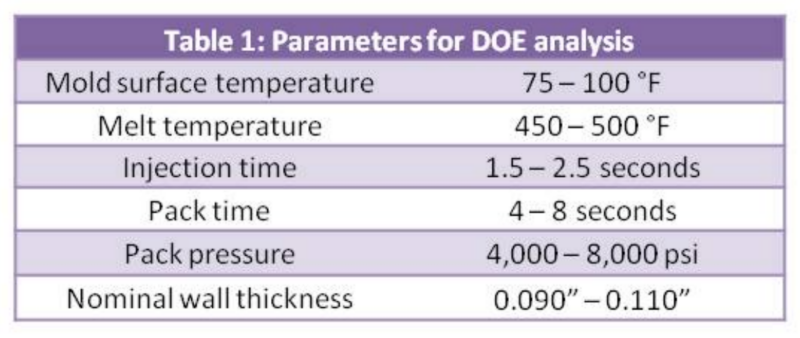
The virtual DOE revealed that long injection times and high melt temperatures can significantly reduce pressure requirements, Figure 3A, and allow for a thinner walled container, Figure 3B. The DOE also showed that long injection times and high melt temperatures can reduce clamp force requirements, Figure 4A. The DOE analysis revealed that the container’s wall thickness can be reduced by as much as 10% from the current nominal wall, and still be manufactured in the 6,000 US ton press, Figure 4B.
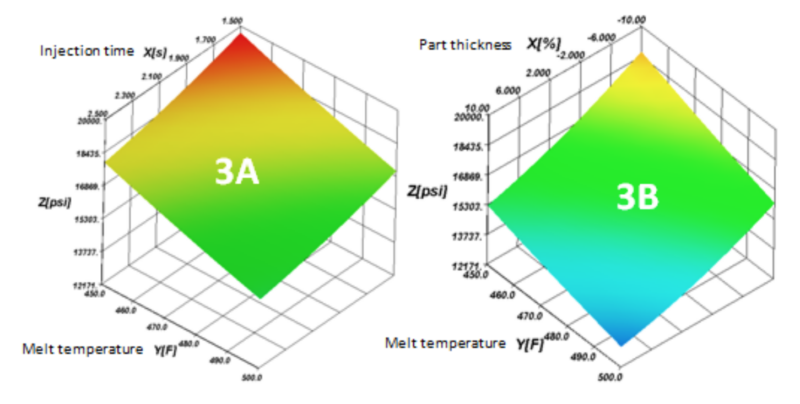
Figure 3: Injection pressure surface response plots.
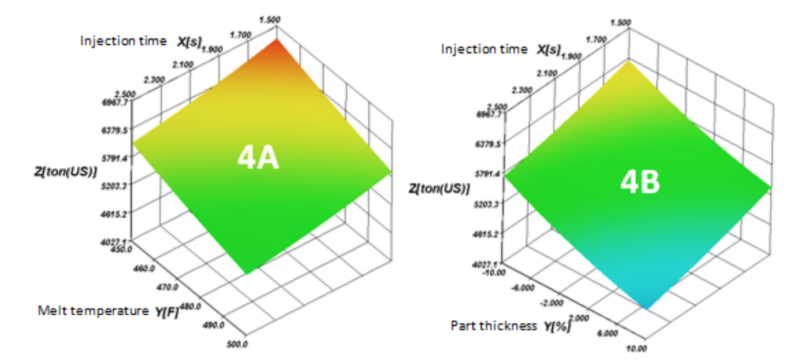
Figure 4: Clamp force surface response plots.
The DOE analysis demonstrated that, as part thickness is reduced, melt temperatures should be increased to minimize injection pressure and clamp force. Additionally, this showed no significant effects on the predicted cycle time for the part. However, as melt temperatures increase, the probability of thermal degradation also increases. With the wealth of information provided by the DOE analysis, an informed decision can be made to balance the size of the molding window with the cost savings of reducing the part thickness.
In conclusion, injection molding simulation coupled with virtual DOE analysis, allows simulation to become an exploratory tool rather than a check-the-box activity. This allows for significant time and cost savings over the traditional de-coupled staggered approach. Additionally, the data generated through a virtual DOE analysis can reveal complex variable responses that may not be identified through traditional injection molding simulation. The ability to incorporate geometric variables into the virtual DOE significantly extends the information that can be gathered beyond a typical physical DOE.
Learn more about this light-weighting case study here: DOE in Injection Molding Simulation
